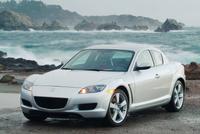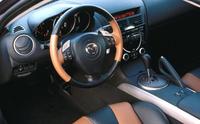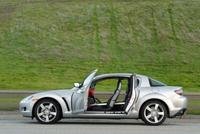New Car Review: 2004 Mazda RX-8
DRIVING DOWN THE ROAD
WITH CAREY RUSS
2004 Mazda RX-8
The legend continues. Mazda didn't invent the Wankel rotary-piston engine, but the Japanese manufacturer has been the most successful in using it for an automotive powerplant, and no other automaker is identified with the rotary engine as much as Mazda. Starting with the Cosmo, a small sports car, in the late 1960s and building its reputation with a series of coupes, sedans, and even a wagon and pickup in the 1970s, Mazda hit its stride with the introduction of the RX-7 in 1978.
With its offering of performance and style at a very competitive price, the RX-7 was one of the harbingers of the end of the automotive Dark Ages of the 1970s. With the second generation, in 1986, the RX-7 gained both refinement and performance, especially when the turbocharged model was released. The third-generation RX-7, sold here between 1993 and 1995, was truly a supercar in all but the nameplate. Its sleek looks and seriously sport-tuned suspension would not have been out of place on an Italian exotic. And a 255-horsepower twin-turbo engine in a 2800-lb chassis gave it a near-exotic levels of speed and handling. Its high price and narrow supersport focus reduced sales potential. And then ever more stringent emissions regulations seemed to be the death knell for the rotary engine in the American market. The Mazda Wankel seemingly disappeared after 1995.
Seemingly. The RX-7 soldiered on in Japan for a while. And, in 1999, the ``RX-Evolv'' concept car was shown at the Tokyo Motor Show. It was a distinctive-looking, very angular sports coupe with a difference - it was a 2+2 featuring four doors, with the rear doors rear-hinged and front-opening in the manner of those found on the sides of pickup cabs. And under the hood was a Wankel. Would this mean a new RX-7?
It was too different to be the fourth-generation RX-7. But, with few changes, it did become the new star of the Mazda lineup, the RX-8. The RX-8 really can't be compared directly to the last RX-7, as it is a four-seater oriented toward a broader clientele. But it is most definitely not a soft boulevard cruiser, it is a serious sports-luxury coupe that offers room for four - with easy access thanks to those ``freestyle'' doors, as Mazda calls them. Yes, it's softer and less narrowly-focused than the last RX-7, but it is also considerably less expensive, not even adjusting for inflation. The further-developed twin-rotor engine lacks turbocharging, but now develops 238 clean, low-emissions horsepower even without the turbos. I've been driving one for the past week, and am loath to give it up. Because of the door arrangement, the rear seat is nearly as accessible as that of a sedan, yet the rotary engine's small size and light weight make for ultra-efficient packaging. Light weight and a rigid chassis give the RX-8 the performance and handling expected of a serious sports car, yet it has enough space and versatility to be an everyday car. That's a winning combination.
APPEARANCE: ``Distinctive'' is perhaps not a strong enough word to describe the RX-8's exterior. It will not be confused with anything else, and successfully blends classic 1950s sports-racer cues with contemporary shapes and style. It's busy but cohesive. The protruding grille and separate front fenders in particular echo some of the last front-engined sports-racing cars, while the general shape, long teardrop-shaped passenger cabin, and complex front lighting system under plastic fairings are cutting-edge contemporary. The compact shape makes it look smaller than it is, and, even though the ``freestyle'' doors are apparent, the RX-8s still has the proportions of a two-seat coupe. The Wankel rotor's curved triangular shape is used in ornamentation of the lower front and rear fascias, and is also embossed at the rear of the hood, directly over the engine.
COMFORT: ``Convenience'' is a word not often used in describing a sports coupe. The genre is notorious for rear seats that are difficult to get into or out of, and offer little space for humans over the age of 10. ``2+2'' apparently means ``two adults plus two small suitcases.'' The RX-8 is different. The freestyle doors, with no central ``B'' pillar, mean easy access for all four passengers. Four six-footers are not in the design spec, but a five-eight person can fit comfortably behind a six-foot front passenger. All four seats are comfortably-padded and bolstered for support in spirited driving - and check out the Wankel-rotor shaped inserts in the front headrests. Make no mistake, the RX-8 is a driver's car, with very good instrumentation and near-perfect positioning of the controls. For convenience, both front and rear passengers have small storage boxes and cupholders in the center console, and there is a passthrough to the trunk, although the space-saver spare tire must be moved or removed to use that feature. Trunk space is far from station wagon standards but decent for a coupe. The RX-8 is as useful around town as it is fun to drive on the open road, and can easily be an only car, not just a weekend toy.
SAFETY: The Mazda RX-8 meets or exceeds all Federal safety requirements, and features active safety equipment including four-wheel vented antilock disc brakes and available dynamic stability control.
ROADABILITY: Despite the two large door holes in the sides of its unibody structure, the RX-8 is commendably rigid, much more so than the last RX-7. The small physical size of the rotary-piston engine allows it to be placed far back in the chassis, for what Mazda calls ``an advanced front-midship'' layout. All important masses are within the relatively long 106-inch wheelbase, for the 50/50 weight distribution and mass centralization that means nimble, precise handling. Handling is further improved by the lower unsprung weight of the aluminum suspension arms. When the six-speed manual gearbox is specified, 18-, instead of 16-inch wheels and ultra-low profile performance tires, a limited-slip differential, and a firmer suspension tuning are included. These all benefit handling response, with little negative effect on comfort. The RX-8 is more ``sport-touring'' than the third-generation RX-7, but for everyday use that's better. It's still serious fun on the right kind of road, and it's not punishing at all on a long highway trip.
PERFORMANCE: The RX-8's heart is its 1.3-liter twin-rotor rotary piston engine. Compared to earlier Mazda rotaries, this one is designed for lower emissions and improved fuel economy. The intake and exhaust ports are larger, and repositioned. A three-position intake manifold and electronic throttle control further improve response. But don't think this means that these changes mean a lack of power - with 238 horsepower at 8500 rpm and 159 lb-ft of torque at 5500 rpm with the six-speed gearbox, it isn't all that less powerful than the last RX-7 despite the lack of turbochargers. (Examples fitted with the four-speed automatic are retuned, for less horsepower and more torque, with 197 hp at 7200 rpm and 159 lb-ft at 5000.) Because it has no reciprocating masses, it is turbine-smooth. There is sufficient power for normal driving above 3,000 rpm, where is makes a sporty four-cylinder snarl. The real power starts above 5000, and continues to the 9000-rpm redline, with a ferocious buzz coming from the twin exhausts. The six-speed gearbox features smooth, precise linkage and well-chosen ratios, and the arrangement of the drilled aluminum pedals is conducive to heel-and-toe shifting.
CONCLUSIONS: Against all odds, Mazda has developed the rotary-piston engine even further in its innovative new RX-8 sports coupe.
SPECIFICATIONS 2004 Mazda RX-8Base Price $ 26,680 Price As Tested $ 33,760 Engine Type Naturally-aspirated twin-rotor Wankel Engine Size 1.3 liters / 79 cu. in. Horsepower 238 @ 8500 rpm Torque (lb-ft) 159 @ 5500 rpm Transmission 6-speed manual Wheelbase / Length 106.4 in. / 174.3 in. Curb Weight 3029 lbs. Pounds Per Horsepower 12.7 Fuel Capacity 15.9 gal. Fuel Requirement 91-octane unleaded premium gasoline Tires P225/45 WR18 Dunlop SP Sport 8090 Brakes, front/rear vented disc / vented discs, antilock standard Suspension, front/rear independent double wishbone / independent multilink Drivetrain front engine, rear-wheel drive
PERFORMANCE EPA Fuel Economy - miles per gallon city / highway / observed 18 / 24 / 17 0 to 60 mph 6.0 sec OPTIONS AND CHARGES
Grand Touring Package - includes: xenon headlights, DSC with traction control, Bose(tm) audio system, day/night mirror with Homelink, moonroof, leather-trimmed upholstery, faux-leather door trim, 8-way power driver's seat, heated seats and mirrors, lumbar support, fog lamps $ 4,000 Navigation system $ 2,000 In-dash 6-disc CD changer $ 500 All-weather floor mats $ 60 Destination and delivery $ 520HISTORY of the WANKLE ENGINE
Given Mazda's success with it, you might think that the rotary-piston engine was a Mazda invention. Not true - rotary-piston engines have been proposed since before the age of internal combustion. But all except one were merely historical footnotes. That one is the Wankel, and its only current automotive proponent is Mazda.
The Wankel engine was developed by German inventor Felix Wankel, beginning with drawings and prototypes in the 1920s. His first patent for a rotary piston engine was granted in 1936. But it was not until the 1950s, when Wankel began collaboration with German car and motorcycle manufacturer NSU, that the Wankel rotary was developed to the point of actually being useable in a motor vehicle.
Wankel thoroughly investigated shapes for both the rotor and the housing of the engine to bear his name, discovering over 800 possible shapes. The majority were impractical, but Wankel thoroughly investigated nearly 150 basic configurations and many variations on each - long before computer simulation was possible. And you were wondering why development took so long....
Early Wankel engines were of a design called ``drehkolbenmaschine'' (DKM) in which an inner rotating housing and rotor move around a fixed central shaft. It was remarkably smooth in operation, and could run at fantastic speeds - over 20,000 rpm - but the engine needed to be disassembled in order to change the spark plugs, This was not a good characteristic for a production powerplant. So the ``kreiskolbenmotor'' (KKM) was developed. In the KKM, the rotor and output shaft rotate inside a fixed housing. Spark plugs are easily accessible on the housing. Intake and exhaust are by ports on the housing, similar in principle to a two-stroke piston engine. All current working Wankels are of KKM design.
The rotor design that worked best was shaped like a triangle with convex edges, while the shape of the interior of the housing is a vaguely figure-eight shape called a two-lobed epitrochoid. The Wankel engine operates on the same four-phase cycle as any other internal combustion engine, with intake, compression, ignition, and exhaust. Unlike a piston engine, but similarly to a gas turbine, each phase takes place in a different area of the engine. The output shaft rotates at three times the rate of the rotor, and there is one ignition pulse for each rotation of the output shaft.
The main advantages of a Wankel engine are size, simplicity, and smoothness. A single-rotor Wankel has two moving parts - the rotor and the crankshaft. Add one more rotor, as in most Mazda rotaries, and there are still only three main moving parts. Because intake and exhaust timing are taken care of by ports on the periphery or ends of the housing, there are no camshafts or valves. There are no reciprocating masses (like the pistons and connecting rods in a piston engine), so the Wankel has very little vibration. And that 3:1 ratio between the output shaft and pistons means that piston rotation speeds are not nearly as spectacular as they might seem - when an RX-8 engine is hitting redline at 9,000 rpm, the pistons are only rotating at 3,000 rpm.
So, if the Wankel has so many advantages, why is it that only Mazda is making Wankel-powered cars? There are disadvantages. Because of the long, narrow combustion chamber shape, the Wankel is less efficient than a regular four-stroke piston engine. Fuel consumption is high, especially in the earlier, less-sophisticated engines. If power output is more important than economy, as in a sports car, this is less of a problem. Nitrogen oxide emissions are lower than in a piston engine, but carbon monoxide and unburned hydrocarbon emissions are higher. The rotor tip seals are analogous to piston rings in a regular engine, but are considerably smaller and so lead a rough life. Seal life in early engines was short - I'll bet that I'm not the only person with memories of RX-2s and RX-3 buzzing along, trailing clouds of noxious blue unburned hydrocarbon smoke. Later improvements in seal design and construction stopped that particular problem.
It was thought that no Wankel could meet current California emissions requirements, but Mazda engineers persevered and met those stringent regulations, primarily by reconfiguring the design so that the intake and exhaust ports are on the sides of the RX-8's chamber instead on the periphery. Careful port design and a three-stage intake manifold further reduce emissions, and help to improve fuel economy. Driven gently, the RX-8 has reasonable fuel consumption. But spin it up and drive it hard, and watch the fuel gauge drop. Hey, it's a sports car, just put gasoline on your entertainment budget.
History Unsurprisingly, the first Wankel-powered cars were experimental NSU sedans built in the late 1950s and early 1960s. The first production Wankel-powered car was the NSU Spider, built from 1964 through 1967. It was a tiny two-seater with a single-rotor 500cc engine that produced 50 horsepower. It was followed in 1968 by the NSU R080, a four-door sedan with a twin-rotor engine that was essentially a doubled version of the Spider engine. The NSU name is not exactly a household word today, which is not surprising as the company was absorbed into the Volkswagen Group in the late 1960s. NSU Wankel development stopped at that time.
In the late 1950s and early 1960s, the Wankel was new and exciting, and hyped as ``tomorrow's power.'' Many major automakers licensed the technology from NSU. General Motors built a couple of mid-engined two- and four-rotor Corvette prototypes in the early 1970s; emissions difficulties, politics, and the first oil crisis meant that the mid-engined Wankel Corvette was merely a legendary might-have-been. Mercedes-Benz built a number of concept cars and prototypes during the `60s and `70s, culminating with a small number of C111s. Powered by both three- and four-rotor engines, C111s were capable of sub-five second 0-60 acceleration. One was modified for speed records, and reached 250 mph. Alas, like the rotary Corvette, the Mercedes supercar fell victim to the 1970s oil crises and company politics.
The first Mazda rotary-powered car was the Cosmo 110S of 1967, a two-place sports car with a very Italian look. It was followed in short order by coupes and sedans, and Mazda had produced over 100,000 rotary engines by 1970. That was merely the beginning. The RX-2, -3, -4, and -5 coupes, sedans, and even wagons put Mazda and the Wankel engine on the map during the 1970s. There was even a rotary-powered pickup. Then, in 1978, the RX-7 made its debut. Three generations of RX-7 left an indelible mark on the automotive scene. First- and second-generation RX-7s are still keeping low-budget enthusiasts and club racers happy.
Does the rotary have a future? If emissions can be problematic running on gasoline, the Wankel seems perfectly happy running on hydrogen. Mazda has built and tested several hydrogen-powered rotary concept vehicles. Don't count the Dr. Wankel's little gem out.





